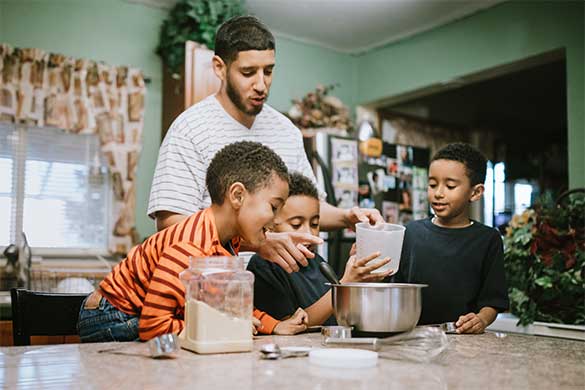Math is part of our everyday lives, and April is Math Awareness Month.
As much as you or I might cringe at the idea of having to help our child with math at home, it doesn’t have to be overwhelming. Look around and you’ll see that your home is filled with various opportunities to practice, learn about and discover math.
You can use some fun at-home activities to increase skills in classification, seriation, numbers and telling time.
Math in the Kitchen
The kitchen holds endless possibilities for math exploration. One idea is to ask your child to compare items by weight. They can, for example, weigh the difference between a box of pasta and a bag of sugar, or perhaps an apple versus a jar of applesauce.
While putting away groceries, ask your child to describe the shapes of packages some might be rectangle, cylinder, cube, square, or circle. You are talking geometry.
Putting grocery items away is one way to teach seriation, a term that refers to the ability to sort objects according to size, color, shape or type. Preschoolers should be able to group based on size or color. Older children may choose different classifications for groups, such as fruit, veggies or dairy.
These skills are often related to more complex math concepts, such as ordination or placing numbers in the correct order.
Delicious Math is in The Oven
Baking together is another kitchen opportunity. Making cookies is an excellent way to practice math skills, such as making sense of numbers.
Have your child help gather the ingredients, counting the number of eggs, for example. Measuring ingredients is a great way to learn about fractions. Learning how a ¼-cup looks compared to a full cup is another place where kids can learn. You can work with them to figure out how math would work if you were doubling the recipe. Then apply that to how you might make half a batch.
Looking at measuring cups or spoons for seriation of sizes. Using the slice and bake style offers a chance for multiplication. Have your child line up unbaked cookies in equal rows. Ask how many in each row, how many rows there are and how many cookies all together. Math in the kitchen may help get the groceries put away and sometimes it come with a yummy result.
Shopping While Teaching Math
Expanding beyond the kitchen another to introduce or build on math in real world settings. While at the store, have your school age child use cash to pay for items. Ask “Do you have enough money? How much do you need?”
This is one way to help children see how math relates to the world and a chance to discuss what happens if they don’t have enough.
Using the Clock as a Teaching Tool
Time is another place where math can be taught. Using a clock with hands, you can have younger kids practice telling time. Ask your child “What time is it now? How many minutes before the next hour?”
You can also do this while estimating times riding in the car. It’s another math concept that can be worked on during a drive. Ask them to add the minutes together to equal an hour.
Make Measurements Fun and Math-Focused
Numbers can be seen in various types of measurements; use a yard stick, ruler or measuring tape to measure spaces or items in and around your home. Have the kids think of things to measure. Prior to the actual measuring have the child estimate how big they think it will be.
Math is more than just the basics of adding, subtracting, multiplying and dividing. It’s a lifelong skill that you can practice in fun and easy ways around your home. It’s full of things that will encourage kids to enjoy math and at the same time build on their abilities.
When kids use math in everyday experiences, they can see that it’s real, it can be fun and that it has a consistent set of uses. For many kids, seeing how it’s “real” makes the lessons stronger than those out of a textbook.
By Twila Perkinson, Certified Child Life Specialist and Avera Family Life Educator


